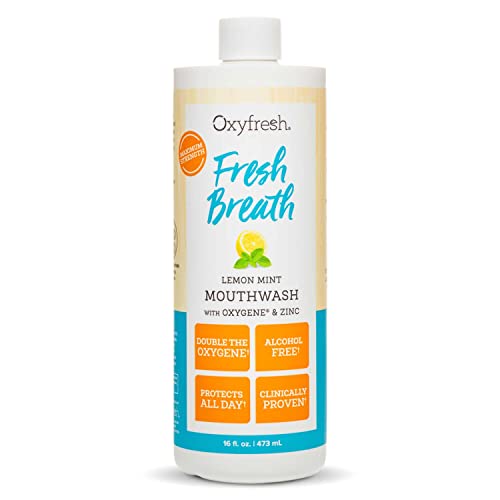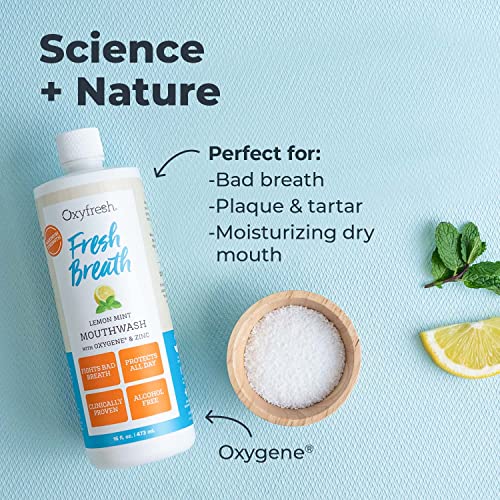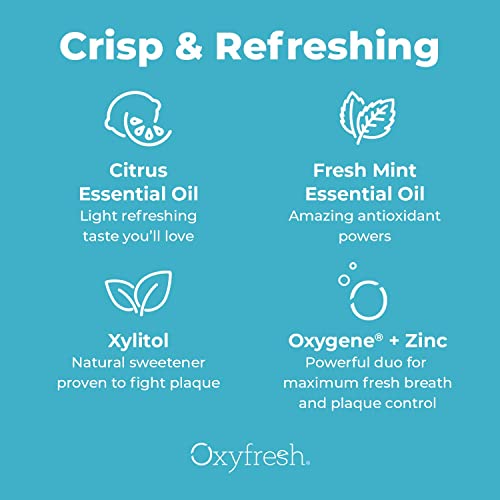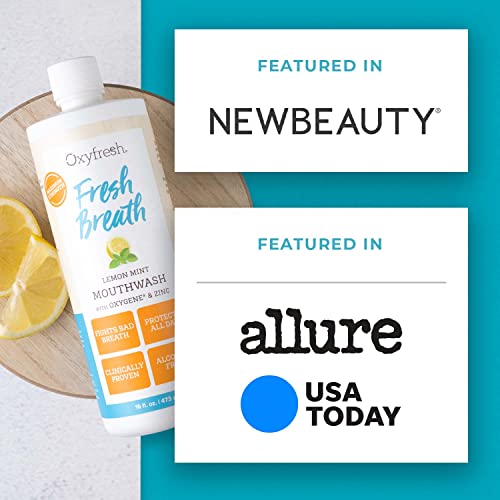







Oxyfresh Premium Mouthwash - Neutralizes Bad Breath, Hydrating & Non-Toxic - Lemon Mint, 16oz


Citrus Aurantium Bergamia (Bergamot) Fruit Extract
High RiskCitrus aurantium bergamia (bergamot) fruit extract is derived from the bergamot orange, primarily used for its aromatic properties and as a flavoring agent. It is commonly found in personal care products and fragrances, where it serves to enhance scent profiles.
Sustai Insights
Bergamot extract offers functional benefits such as providing fragrance and potential skin conditioning. However, it carries significant health risks, including a high potential for allergic reactions and skin irritation. Environmental concerns include its classification under certain regulations that restrict its use due to irritation potential. The ingredient is considered to have a high overall risk level, necessitating caution in its application, particularly for sensitive populations. Alternatives such as synthetic fragrances or other essential oils may provide safer options.
Sodium Hydroxide
High RiskSodium hydroxide is a highly caustic and reactive inorganic compound commonly used as a pH adjuster in various products. It is effective in neutralizing acids and plays a role in the production of soaps and detergents.
Sustai Insights
Sodium hydroxide serves essential functions, particularly in adjusting pH levels, but poses significant health risks, including skin and eye irritation. It is subject to high usage restrictions due to its corrosive nature. Environmental concerns include its potential to pollute water sources and contribute to ecosystem damage. Regulatory bodies have imposed strict guidelines on its use, indicating a high-risk profile for products containing this ingredient. Safe handling practices are crucial, and alternatives include milder pH adjusters, emphasizing the need for caution in its application.
Zinc Acetate
High RiskZinc acetate is a zinc salt of acetic acid. It is commonly used in various products for its role in providing zinc, an essential trace element, which is important for numerous biological functions.
Sustai Insights
Zinc acetate effectively serves as a zinc supplement and can enhance skin health and wound healing. However, regulatory warnings indicate high usage restrictions, and while it poses low risks for cancer, allergies, and reproductive toxicity, concerns exist regarding its persistence and bioaccumulation in the environment. Given these factors, the overall risk level is assessed as high, necessitating cautious usage and consideration of safer alternatives.
Picea Mariana Leaf Oil
High RiskPicea mariana leaf oil, derived from the needles of the black spruce tree, is commonly used in personal care products for its aromatic properties and potential skin benefits. It functions primarily as a fragrance component and may also have preservative qualities due to its natural antimicrobial properties.
Sustai Insights
Picea mariana leaf oil offers functional benefits as a natural fragrance and potential antimicrobial agent, which can enhance product stability. However, it carries high usage restrictions and is associated with low risk for carcinogenicity, allergies, and reproductive toxicity. Environmental concerns include potential pollution and bioaccumulation. Regulatory warnings indicate heightened caution in use. Overall, the ingredient presents a high risk assessment, and users are advised to consider safer alternatives or limit exposure.
Citrus Grandis (Grapefruit)
High RiskCitrus grandis (grapefruit) is a plant material commonly used in various products for its aromatic properties and potential skin benefits. It is often incorporated in cosmetics and personal care products for fragrance, antioxidant qualities, and as a natural preservative.
Sustai Insights
Citrus grandis offers functional benefits such as its antioxidant properties and natural fragrance, contributing positively to product formulations. However, it has a high allergenic potential, posing risks of skin and immunotoxic reactions. Environmental concerns include moderate persistence and bioaccumulation, raising ecotoxicity issues. Regulatory bodies have placed restrictions on its use in certain products, leading to an overall high-risk assessment. Safe usage practices are recommended, and alternatives like other citrus extracts or synthetic fragrances may be considered for reduced allergenic potential.
Citric Acid
Medium RiskCitric acid is an alpha hydroxy acid used in personal care products primarily for its role as a pH adjuster and natural preservative. It occurs naturally in citrus fruits and is commonly utilized in various formulations for its chelating properties and mild exfoliation benefits.
Sustai Insights
Citric acid offers functional benefits as an effective preservative and pH stabilizer, contributing to product longevity and stability. It is biodegradable and derived from renewable sources. Health risks are low, with minimal concerns regarding carcinogenicity, allergies, and reproductive toxicity. However, moderate use restrictions exist due to potential irritation at high concentrations. Environmental risks are limited, as citric acid is not known to accumulate in ecosystems. Regulatory agencies have no significant advisories against its use. Overall, it is assessed as a medium-risk ingredient, with safe usage practices recommended and alternatives available.
Potassium Sorbate
Medium RiskPotassium sorbate is a potassium salt of sorbic acid, primarily used as a preservative in food and cosmetic products. It inhibits the growth of molds, yeast, and some bacteria, extending the shelf life of products. It is commonly found in various formulations due to its effectiveness and low toxicity.
Sustai Insights
Potassium sorbate serves as an effective preservative, preventing microbial growth in food and cosmetic products, which is vital for safety and longevity. Although it has a low risk of carcinogenicity and developmental toxicity, there is a moderate concern regarding allergies and immunotoxicity. Environmentally, it poses minimal risks as it is not significantly bioaccumulative. Regulatory agencies have verified its use, although some products may face restrictions. Overall, it is assessed as a medium risk ingredient, with safe usage practices recommended, and alternatives such as natural preservatives could be considered.
Xylitol
Low RiskXylitol is a sugar alcohol used primarily as a sweetener. It is commonly found in oral care products and food items, offering a sweetening effect similar to sugar but with fewer calories. It serves as a humectant and can contribute to dental health by reducing the risk of cavities.
Sustai Insights
Xylitol provides functional benefits as a low-calorie sweetener and may help improve dental health by inhibiting cavity-causing bacteria. It is generally recognized as safe by the FDA with low concern for cancer, allergies, or reproductive toxicity. Environmental risks are minimal, as xylitol is biodegradable and does not accumulate in the ecosystem. Regulatory bodies have not imposed significant restrictions. Overall, xylitol presents a low risk when used appropriately, with no major adverse health effects reported and sustainable sourcing options available.
Orange
Low RiskOrange, derived from the fruit of the Citrus sinensis tree, is commonly used in various products for its aromatic properties and as a flavoring agent. It is often employed for its potential to enhance sensory appeal in food and cosmetic formulations.
Sustai Insights
Orange offers functional benefits such as flavor enhancement and fragrance in products. It is generally considered safe with low concerns regarding carcinogenicity, allergies, and reproductive toxicity. Environmental risks are minimal, as it does not significantly contribute to pollution or bioaccumulation. Regulatory bodies have no current restrictions on its use. Overall, orange is assessed to have a low risk profile, making it a viable option in formulations.
Sucralose
Low RiskSucralose is a chlorinated derivative of sucrose, commonly used as a non-caloric sweetener in various food and beverage products. It is approximately 600 times sweeter than sugar and is stable under heat, making it suitable for cooking and baking applications.
Sustai Insights
Sucralose offers functional benefits as an effective sweetener without contributing calories, making it a popular choice in diet products. It is generally considered safe, with low concerns regarding carcinogenicity, allergies, and reproductive toxicity. However, it has moderate persistence and bioaccumulation potential in the environment. Regulatory bodies like the FDA approve its use, with no significant advisories. Overall, it poses a low risk to health and the environment, with safe usage practices supporting its incorporation in various products.
Water
Low RiskWater is a clear, colorless liquid essential for various biological processes. It serves as a solvent in formulations, facilitating the dissolution of other ingredients and enhancing product texture and application. Additionally, water plays a crucial role in hydration and is a key component in many cosmetic and personal care products.
Sustai Insights
Water is an effective solvent and hydrator, contributing to the texture and efficacy of formulations. It is biodegradable and generally regarded as safe, with low concerns regarding carcinogenicity, allergies, and reproductive toxicity. However, excessive water usage can lead to environmental concerns, particularly regarding resource depletion. Regulatory bodies do not impose restrictions on water use in cosmetics. Overall, the risks associated with water are low, making it a safe and essential ingredient.
Sodium Citrate
Low RiskSodium citrate is used in cosmetic formulations primarily as a buffering agent, helping to stabilize pH levels. It is derived from citric acid and is commonly found in various personal care products to enhance their efficacy and stability.
Sustai Insights
Sodium citrate offers functional benefits such as effective pH regulation and acts as a mild preservative. It is generally recognized as safe with low risks for cancer, allergies, and reproductive toxicity. Environmental concerns are minimal, with no significant pollutant potential or bioaccumulation. Regulatory bodies like the FDA and COSMOS have no major restrictions on its use. Overall, sodium citrate presents a low risk, making it a viable ingredient in cosmetic formulations. Safe usage practices should be followed, and alternatives are not typically necessary.
Peg 40 Hydrogenated Castor Oil
Low RiskPEG-40 hydrogenated castor oil is a polyethylene glycol derivative of hydrogenated castor oil, commonly used as an emulsifier and surfactant in various cosmetic and personal care products. It helps to improve the texture and stability of formulations by facilitating the blending of oil and water-based ingredients.
Sustai Insights
PEG-40 hydrogenated castor oil offers functional benefits such as effective emulsification and stability enhancement in formulations. It is considered low risk for health concerns, including carcinogenicity and allergenic potential. Environmentally, it is not associated with significant hazards, and regulatory bodies have not imposed strict restrictions. Safe usage practices involve adhering to recommended concentrations. Overall, this ingredient presents a low risk profile with limited environmental impact, making it a suitable choice in cosmetic applications.
Xylitol
Low RiskXylitol is a sugar alcohol used primarily as a sweetener. It is commonly found in oral care products and food items, offering a sweetening effect similar to sugar but with fewer calories. It serves as a humectant and can contribute to dental health by reducing the risk of cavities.
Sustai Insights
Xylitol provides functional benefits as a low-calorie sweetener and may help improve dental health by inhibiting cavity-causing bacteria. It is generally recognized as safe by the FDA with low concern for cancer, allergies, or reproductive toxicity. Environmental risks are minimal, as xylitol is biodegradable and does not accumulate in the ecosystem. Regulatory bodies have not imposed significant restrictions. Overall, xylitol presents a low risk when used appropriately, with no major adverse health effects reported and sustainable sourcing options available.
Citrus Aurantium Bergamia (Bergamot) Fruit Extract
High RiskCitrus aurantium bergamia (bergamot) fruit extract is derived from the bergamot orange, primarily used for its aromatic properties and as a flavoring agent. It is commonly found in personal care products and fragrances, where it serves to enhance scent profiles.
Sustai Insights
Bergamot extract offers functional benefits such as providing fragrance and potential skin conditioning. However, it carries significant health risks, including a high potential for allergic reactions and skin irritation. Environmental concerns include its classification under certain regulations that restrict its use due to irritation potential. The ingredient is considered to have a high overall risk level, necessitating caution in its application, particularly for sensitive populations. Alternatives such as synthetic fragrances or other essential oils may provide safer options.
Orange
Low RiskOrange, derived from the fruit of the Citrus sinensis tree, is commonly used in various products for its aromatic properties and as a flavoring agent. It is often employed for its potential to enhance sensory appeal in food and cosmetic formulations.
Sustai Insights
Orange offers functional benefits such as flavor enhancement and fragrance in products. It is generally considered safe with low concerns regarding carcinogenicity, allergies, and reproductive toxicity. Environmental risks are minimal, as it does not significantly contribute to pollution or bioaccumulation. Regulatory bodies have no current restrictions on its use. Overall, orange is assessed to have a low risk profile, making it a viable option in formulations.
Citric Acid
Medium RiskCitric acid is an alpha hydroxy acid used in personal care products primarily for its role as a pH adjuster and natural preservative. It occurs naturally in citrus fruits and is commonly utilized in various formulations for its chelating properties and mild exfoliation benefits.
Sustai Insights
Citric acid offers functional benefits as an effective preservative and pH stabilizer, contributing to product longevity and stability. It is biodegradable and derived from renewable sources. Health risks are low, with minimal concerns regarding carcinogenicity, allergies, and reproductive toxicity. However, moderate use restrictions exist due to potential irritation at high concentrations. Environmental risks are limited, as citric acid is not known to accumulate in ecosystems. Regulatory agencies have no significant advisories against its use. Overall, it is assessed as a medium-risk ingredient, with safe usage practices recommended and alternatives available.
Sodium Hydroxide
High RiskSodium hydroxide is a highly caustic and reactive inorganic compound commonly used as a pH adjuster in various products. It is effective in neutralizing acids and plays a role in the production of soaps and detergents.
Sustai Insights
Sodium hydroxide serves essential functions, particularly in adjusting pH levels, but poses significant health risks, including skin and eye irritation. It is subject to high usage restrictions due to its corrosive nature. Environmental concerns include its potential to pollute water sources and contribute to ecosystem damage. Regulatory bodies have imposed strict guidelines on its use, indicating a high-risk profile for products containing this ingredient. Safe handling practices are crucial, and alternatives include milder pH adjusters, emphasizing the need for caution in its application.
Sucralose
Low RiskSucralose is a chlorinated derivative of sucrose, commonly used as a non-caloric sweetener in various food and beverage products. It is approximately 600 times sweeter than sugar and is stable under heat, making it suitable for cooking and baking applications.
Sustai Insights
Sucralose offers functional benefits as an effective sweetener without contributing calories, making it a popular choice in diet products. It is generally considered safe, with low concerns regarding carcinogenicity, allergies, and reproductive toxicity. However, it has moderate persistence and bioaccumulation potential in the environment. Regulatory bodies like the FDA approve its use, with no significant advisories. Overall, it poses a low risk to health and the environment, with safe usage practices supporting its incorporation in various products.
Potassium Sorbate
Medium RiskPotassium sorbate is a potassium salt of sorbic acid, primarily used as a preservative in food and cosmetic products. It inhibits the growth of molds, yeast, and some bacteria, extending the shelf life of products. It is commonly found in various formulations due to its effectiveness and low toxicity.
Sustai Insights
Potassium sorbate serves as an effective preservative, preventing microbial growth in food and cosmetic products, which is vital for safety and longevity. Although it has a low risk of carcinogenicity and developmental toxicity, there is a moderate concern regarding allergies and immunotoxicity. Environmentally, it poses minimal risks as it is not significantly bioaccumulative. Regulatory agencies have verified its use, although some products may face restrictions. Overall, it is assessed as a medium risk ingredient, with safe usage practices recommended, and alternatives such as natural preservatives could be considered.
Water
Low RiskWater is a clear, colorless liquid essential for various biological processes. It serves as a solvent in formulations, facilitating the dissolution of other ingredients and enhancing product texture and application. Additionally, water plays a crucial role in hydration and is a key component in many cosmetic and personal care products.
Sustai Insights
Water is an effective solvent and hydrator, contributing to the texture and efficacy of formulations. It is biodegradable and generally regarded as safe, with low concerns regarding carcinogenicity, allergies, and reproductive toxicity. However, excessive water usage can lead to environmental concerns, particularly regarding resource depletion. Regulatory bodies do not impose restrictions on water use in cosmetics. Overall, the risks associated with water are low, making it a safe and essential ingredient.
Zinc Acetate
High RiskZinc acetate is a zinc salt of acetic acid. It is commonly used in various products for its role in providing zinc, an essential trace element, which is important for numerous biological functions.
Sustai Insights
Zinc acetate effectively serves as a zinc supplement and can enhance skin health and wound healing. However, regulatory warnings indicate high usage restrictions, and while it poses low risks for cancer, allergies, and reproductive toxicity, concerns exist regarding its persistence and bioaccumulation in the environment. Given these factors, the overall risk level is assessed as high, necessitating cautious usage and consideration of safer alternatives.
Sodium Citrate
Low RiskSodium citrate is used in cosmetic formulations primarily as a buffering agent, helping to stabilize pH levels. It is derived from citric acid and is commonly found in various personal care products to enhance their efficacy and stability.
Sustai Insights
Sodium citrate offers functional benefits such as effective pH regulation and acts as a mild preservative. It is generally recognized as safe with low risks for cancer, allergies, and reproductive toxicity. Environmental concerns are minimal, with no significant pollutant potential or bioaccumulation. Regulatory bodies like the FDA and COSMOS have no major restrictions on its use. Overall, sodium citrate presents a low risk, making it a viable ingredient in cosmetic formulations. Safe usage practices should be followed, and alternatives are not typically necessary.
Picea Mariana Leaf Oil
High RiskPicea mariana leaf oil, derived from the needles of the black spruce tree, is commonly used in personal care products for its aromatic properties and potential skin benefits. It functions primarily as a fragrance component and may also have preservative qualities due to its natural antimicrobial properties.
Sustai Insights
Picea mariana leaf oil offers functional benefits as a natural fragrance and potential antimicrobial agent, which can enhance product stability. However, it carries high usage restrictions and is associated with low risk for carcinogenicity, allergies, and reproductive toxicity. Environmental concerns include potential pollution and bioaccumulation. Regulatory warnings indicate heightened caution in use. Overall, the ingredient presents a high risk assessment, and users are advised to consider safer alternatives or limit exposure.
Citrus Grandis (Grapefruit)
High RiskCitrus grandis (grapefruit) is a plant material commonly used in various products for its aromatic properties and potential skin benefits. It is often incorporated in cosmetics and personal care products for fragrance, antioxidant qualities, and as a natural preservative.
Sustai Insights
Citrus grandis offers functional benefits such as its antioxidant properties and natural fragrance, contributing positively to product formulations. However, it has a high allergenic potential, posing risks of skin and immunotoxic reactions. Environmental concerns include moderate persistence and bioaccumulation, raising ecotoxicity issues. Regulatory bodies have placed restrictions on its use in certain products, leading to an overall high-risk assessment. Safe usage practices are recommended, and alternatives like other citrus extracts or synthetic fragrances may be considered for reduced allergenic potential.
Peg 40 Hydrogenated Castor Oil
Low RiskPEG-40 hydrogenated castor oil is a polyethylene glycol derivative of hydrogenated castor oil, commonly used as an emulsifier and surfactant in various cosmetic and personal care products. It helps to improve the texture and stability of formulations by facilitating the blending of oil and water-based ingredients.
Sustai Insights
PEG-40 hydrogenated castor oil offers functional benefits such as effective emulsification and stability enhancement in formulations. It is considered low risk for health concerns, including carcinogenicity and allergenic potential. Environmentally, it is not associated with significant hazards, and regulatory bodies have not imposed strict restrictions. Safe usage practices involve adhering to recommended concentrations. Overall, this ingredient presents a low risk profile with limited environmental impact, making it a suitable choice in cosmetic applications.
Discover the power of fresh breath with Premium Oxyfresh Lemon Mint Mouthwash, a gentle, alcohol-free oral rinse designed to combat bad breath effectively. This refreshing mouthwash is perfect for health-conscious families, delivering all-day freshness without harsh chemicals.
- Fights Bad Breath: Neutralizes odors in just one minute, providing long-lasting freshness without masking the smell.
- Hydrating & Alcohol-Free: Contains soothing aloe vera to hydrate gums, ensuring a gentle experience that won’t dry out your mouth.
- Natural Ingredients: Infused with xylitol and essential oils, it helps fight plaque while offering a delicious citrus and spearmint flavor.
- Clinically Proven: Backed by a 12-month independent study, this mouthwash shows effective results in reducing plaque and strengthening gum tissue.
- Safe & Non-Toxic: Made in the USA, it’s fluoride-free and trusted by dentists, ensuring a safe choice for the whole family.
Subscribe & Save with Sustai
- Best Price Guarantee: Always enjoy the lowest prices on sustainable home essentials.
- No Surprises: We’ll notify you before shipping. No hidden fees, ever.
- You’re in Charge: Change, pause, or cancel your subscription anytime with ease.
- Eco-Friendly Deliveries: Our grouped shipments mean less packaging and lower emissions.
Join us on a sustainable journey. Special offers for a limited time! Prices and promotions may change.
Recommended Products
Discover the power of fresh breath with Premium Oxyfresh Lemon Mint Mouthwash, a gentle, alcohol-free oral rinse designed to combat bad breath effectively. This refreshing mouthwash is perfect for health-conscious families, delivering all-day freshness without harsh chemicals.
- Fights Bad Breath: Neutralizes odors in just one minute, providing long-lasting freshness without masking the smell.
- Hydrating & Alcohol-Free: Contains soothing aloe vera to hydrate gums, ensuring a gentle experience that won’t dry out your mouth.
- Natural Ingredients: Infused with xylitol and essential oils, it helps fight plaque while offering a delicious citrus and spearmint flavor.
- Clinically Proven: Backed by a 12-month independent study, this mouthwash shows effective results in reducing plaque and strengthening gum tissue.
- Safe & Non-Toxic: Made in the USA, it’s fluoride-free and trusted by dentists, ensuring a safe choice for the whole family.

You can have at most 2 Sustainable Steals products in your cart
Customer Reviews
Customers’ View
Customers appreciate the effectiveness and gentle formulation of Oxyfresh Mouthwash, highlighting its alcohol-free nature which prevents gum dryness. Users frequently mention the refreshing lemon and mint flavor, with one customer noting it leaves a pleasant taste, likening it to feeling freshly cleaned by a dentist. Many find the mouthwash mild yet effective against bad breath and plaque buildup, making it suitable for daily use. Reviewers also value its natural ingredients, including xylitol and essential oils, which align with health-conscious preferences. Overall, customers find Oxyfresh Mouthwash to be a reliable choice that promotes oral health without harsh additives.
AI-generated from the text of customer reviewsThis product is rated 4.8 of 5.0 stars.
It has received 17 reviews.




